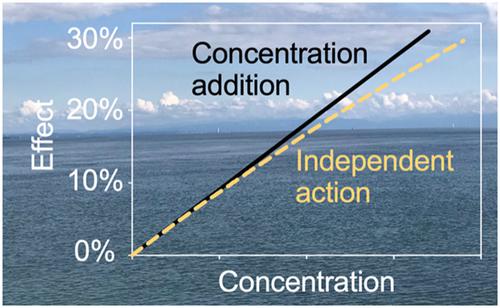当前位置:
X-MOL 学术
›
Environ. Toxicol. Chem.
›
论文详情
Our official English website, www.x-mol.net, welcomes your
feedback! (Note: you will need to create a separate account there.)
Exploring the Concepts of Concentration Addition and Independent Action Using a Linear Low-Effect Mixture Model.
Environmental Toxicology and Chemistry ( IF 3.6 ) Pub Date : 2020-09-08 , DOI: 10.1002/etc.4868 Beate Escher 1, 2 , Georg Braun 1 , Christiane Zarfl 2
Environmental Toxicology and Chemistry ( IF 3.6 ) Pub Date : 2020-09-08 , DOI: 10.1002/etc.4868 Beate Escher 1, 2 , Georg Braun 1 , Christiane Zarfl 2
Affiliation

|
Chemicals emitted into the environment are typically present at low concentrations but may act together in mixtures. Concentration–response curves of in vitro bioassays were often linear for effect levels <30%, and the predictions for concentration addition (CA) of similarly acting chemicals and for independent action (IA) of dissimilarly acting chemicals overlapped. We derived a joint CA/IA mixture model for the low‐effect level portion of concentration–response curves. In a first case study, we evaluated the cytotoxicity of over 200 mixtures of up to 17 components that were mixed in concentration ratios as they occurred in river water. The predictions of the full IA model were indistinguishable from the predictions of the full CA model up to 10% effect, confirming the applicability of the joint CA/IA mixture model at low effect levels. In a second case study, we evaluated if environmental concentrations trigger effects at levels low enough for the joint CA/IA mixture model to apply. The detected concentrations were scaled by their toxic potencies to estimate the mixture effect of the detected chemicals in a complex mixture. In 86% of 156 samples the effects fell in the validity range of the joint CA/IA mixture model (<10% effect level), confirming the CA assumption for toxic unit summation. The joint CA/IA mixture model is not suitable for testing specific mixture hypotheses and interactions of chemicals in mixtures, where more refined models are required; but it is helpful for the interpretation of effects of complex (multicomponent) environmental mixtures, especially for water samples with relatively low effect level. Environ Toxicol Chem 2020;39:2552–2559. © 2020 The Authors. Environmental Toxicology and Chemistry published by Wiley Periodicals LLC on behalf of SETAC.
中文翻译:

使用线性低效混合模型探索浓度加和独立作用的概念。
排放到环境中的化学物质通常浓度较低,但可能以混合物形式共同作用。效应水平<30%时,体外生物测定的浓度-响应曲线通常呈线性关系,相似作用的化学物质的浓度增加(CA)和相似作用的化学物质的独立作用(IA)的预测重叠。我们得出了浓度/响应曲线的低效水平部分的联合CA / IA混合模型。在第一个案例研究中,我们评估了超过200种混合物的细胞毒性,这些混合物以浓度比的形式混合了多达17种组分的混合物,这些混合物在河水中发生。完整IA模型的预测与高达10%效果的完整CA模型的预测是无法区分的,从而确认了联合CA / IA混合模型在低效果水平下的适用性。在第二个案例研究中,我们评估了环境浓度是否在足以使联合CA / IA混合模型适用的水平下触发效应。通过检测浓度来确定其浓度,以估计其在复杂混合物中的混合效果。在156个样本中,有86%的影响落在联合CA / IA混合模型的有效范围内(<10%的影响水平),这证实了CA对毒性单位求和的假设。CA / IA联合混合物模型不适用于测试特定的混合物假设和混合物中化学物质的相互作用,因此需要更精细的模型;但这对于解释复杂的(多组分)环境混合物的影响很有帮助,尤其是对于影响水平相对较低的水样。我们评估了环境浓度是否在足以使联合CA / IA混合模型应用的水平较低的水平上引发了影响。通过检测浓度来确定其浓度,以估计其在复杂混合物中的混合效果。在156个样本中,有86%的影响落在联合CA / IA混合模型的有效范围内(<10%的影响水平),这证实了CA对毒性单位求和的假设。CA / IA联合混合物模型不适用于测试特定的混合物假设和混合物中化学物质的相互作用,因此需要更精细的模型;但这对于解释复杂的(多组分)环境混合物的影响很有帮助,尤其是对于影响水平相对较低的水样。我们评估了环境浓度是否在足以使联合CA / IA混合模型应用的水平较低的水平上引发了影响。通过检测浓度来确定其浓度,以估计其在复杂混合物中的混合效果。在156个样本中,有86%的影响落在联合CA / IA混合模型的有效范围内(<10%的影响水平),这证实了CA对毒性单位求和的假设。CA / IA联合混合物模型不适用于测试特定的混合物假设和混合物中化学物质的相互作用,因此需要更精细的模型;但这对于解释复杂的(多组分)环境混合物的影响很有帮助,尤其是对于影响水平相对较低的水样。通过检测浓度来确定其浓度,以估计其在复杂混合物中的混合效果。在156个样本中,有86%的影响落在联合CA / IA混合模型的有效范围内(<10%的影响水平),这证实了CA对毒性单位求和的假设。CA / IA联合混合物模型不适用于测试特定的混合物假设和混合物中化学物质的相互作用,因此需要更精细的模型;但这对于解释复杂的(多组分)环境混合物的影响很有帮助,尤其是对于影响水平相对较低的水样。通过检测浓度来确定其浓度,以估计其在复杂混合物中的混合效果。在156个样本中,有86%的影响落在联合CA / IA混合模型的有效范围内(<10%的影响水平),这证实了CA对毒性单位求和的假设。CA / IA联合混合物模型不适用于测试特定的混合物假设和混合物中化学物质的相互作用,因此需要更精细的模型;但这对于解释复杂的(多组分)环境混合物的影响很有帮助,尤其是对于影响水平相对较低的水样。CA / IA联合混合物模型不适用于测试特定的混合物假设和混合物中化学物质的相互作用,因此需要更精细的模型;但这对于解释复杂的(多组分)环境混合物的影响很有帮助,尤其是对于影响水平相对较低的水样。CA / IA联合混合物模型不适用于测试特定的混合物假设和混合物中化学物质的相互作用,因此需要更精细的模型;但这对于解释复杂的(多组分)环境混合物的影响很有帮助,尤其是对于影响水平相对较低的水样。2020年《环境毒理学》; 39:2552–2559。©2020作者。Wiley Periodicals LLC代表SETAC发布的《环境毒理学和化学》。
更新日期:2020-09-08
中文翻译:

使用线性低效混合模型探索浓度加和独立作用的概念。
排放到环境中的化学物质通常浓度较低,但可能以混合物形式共同作用。效应水平<30%时,体外生物测定的浓度-响应曲线通常呈线性关系,相似作用的化学物质的浓度增加(CA)和相似作用的化学物质的独立作用(IA)的预测重叠。我们得出了浓度/响应曲线的低效水平部分的联合CA / IA混合模型。在第一个案例研究中,我们评估了超过200种混合物的细胞毒性,这些混合物以浓度比的形式混合了多达17种组分的混合物,这些混合物在河水中发生。完整IA模型的预测与高达10%效果的完整CA模型的预测是无法区分的,从而确认了联合CA / IA混合模型在低效果水平下的适用性。在第二个案例研究中,我们评估了环境浓度是否在足以使联合CA / IA混合模型适用的水平下触发效应。通过检测浓度来确定其浓度,以估计其在复杂混合物中的混合效果。在156个样本中,有86%的影响落在联合CA / IA混合模型的有效范围内(<10%的影响水平),这证实了CA对毒性单位求和的假设。CA / IA联合混合物模型不适用于测试特定的混合物假设和混合物中化学物质的相互作用,因此需要更精细的模型;但这对于解释复杂的(多组分)环境混合物的影响很有帮助,尤其是对于影响水平相对较低的水样。我们评估了环境浓度是否在足以使联合CA / IA混合模型应用的水平较低的水平上引发了影响。通过检测浓度来确定其浓度,以估计其在复杂混合物中的混合效果。在156个样本中,有86%的影响落在联合CA / IA混合模型的有效范围内(<10%的影响水平),这证实了CA对毒性单位求和的假设。CA / IA联合混合物模型不适用于测试特定的混合物假设和混合物中化学物质的相互作用,因此需要更精细的模型;但这对于解释复杂的(多组分)环境混合物的影响很有帮助,尤其是对于影响水平相对较低的水样。我们评估了环境浓度是否在足以使联合CA / IA混合模型应用的水平较低的水平上引发了影响。通过检测浓度来确定其浓度,以估计其在复杂混合物中的混合效果。在156个样本中,有86%的影响落在联合CA / IA混合模型的有效范围内(<10%的影响水平),这证实了CA对毒性单位求和的假设。CA / IA联合混合物模型不适用于测试特定的混合物假设和混合物中化学物质的相互作用,因此需要更精细的模型;但这对于解释复杂的(多组分)环境混合物的影响很有帮助,尤其是对于影响水平相对较低的水样。通过检测浓度来确定其浓度,以估计其在复杂混合物中的混合效果。在156个样本中,有86%的影响落在联合CA / IA混合模型的有效范围内(<10%的影响水平),这证实了CA对毒性单位求和的假设。CA / IA联合混合物模型不适用于测试特定的混合物假设和混合物中化学物质的相互作用,因此需要更精细的模型;但这对于解释复杂的(多组分)环境混合物的影响很有帮助,尤其是对于影响水平相对较低的水样。通过检测浓度来确定其浓度,以估计其在复杂混合物中的混合效果。在156个样本中,有86%的影响落在联合CA / IA混合模型的有效范围内(<10%的影响水平),这证实了CA对毒性单位求和的假设。CA / IA联合混合物模型不适用于测试特定的混合物假设和混合物中化学物质的相互作用,因此需要更精细的模型;但这对于解释复杂的(多组分)环境混合物的影响很有帮助,尤其是对于影响水平相对较低的水样。CA / IA联合混合物模型不适用于测试特定的混合物假设和混合物中化学物质的相互作用,因此需要更精细的模型;但这对于解释复杂的(多组分)环境混合物的影响很有帮助,尤其是对于影响水平相对较低的水样。CA / IA联合混合物模型不适用于测试特定的混合物假设和混合物中化学物质的相互作用,因此需要更精细的模型;但这对于解释复杂的(多组分)环境混合物的影响很有帮助,尤其是对于影响水平相对较低的水样。2020年《环境毒理学》; 39:2552–2559。©2020作者。Wiley Periodicals LLC代表SETAC发布的《环境毒理学和化学》。











































 京公网安备 11010802027423号
京公网安备 11010802027423号